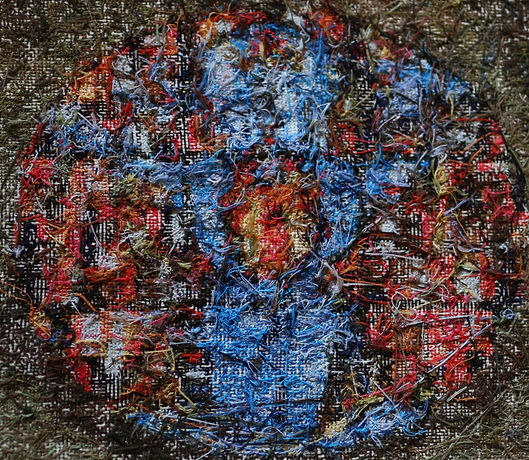
The Underside
of Beauty
See this random, messy field of knots and loose threads?
For too many years, this was my life: a study in mistakes and misfires. In my book Mass Confusion: Why I Rejected the Church For So Long And What Changed, I confess how the worst of me came together—or in my case, unraveled—into something like this picture.


As for what changed, spoiler alert: One day I got it. I got that what I see as my messy, twisted life, in God’s hands, is only the underside of what he knows of me. I got that where I see only frays and breaks, he sees his beloved creation.
I got that life can be a tapestry with two sides.
The photograph above is the underside of a piece of work by Julia, a mother of two who spent her twenties entangled in alcoholism. One day about a year into her sobriety, she found herself on a silent retreat, alone in a monastery chapel. As the noise in her head ebbed to low tide—something new for her—she realized she could do more than just look at the stained-glass window over the altar. She could actually see it. The icons were unfamiliar, but in the absence of deadlines and distractions she could consider the fragments and the whole, and she began to find peace.
“I was there once when I was pregnant, and I remember staring at Jesus in Mary’s belly,” she says. “I thought: I know my fierce love for my children, and I can imagine the story of Mary’s love for Jesus. If God loves me the way I love my children, and maybe even more, how awesome is that?”
After her first visit, Julia never bit her nails again. On the eighth or ninth visit of her now-annual retreats at the monastery, wanting to thank the monks “for taking in prostitutes and tax collectors,” she decided she would cross stitch the window as a gift.

Julia’s chapel-window cross stitch, instead of the walk in the park she expected, became an alpine mountain climb of 24 colors in 22,000 tiny, precise stitches. Completing it took her six months and hundreds of hours. She often drops out of projects, she says, but she stayed with this one, and it became a picture of her sobriety: difficult and daily, and a growing masterpiece. For my part, as grace wove into my life, the idea of a tapestry became my picture of how God redeems even the ways we reject him. Even the worst of what we’ve done or not done—no matter how bad or for how long--becomes part of his beauty.

After I told my story in Mass Confusion and began to build this website, I wanted to show two sides of a tapestry. Not any tapestry, but Julia’s cross stitch: an exquisite, one-of-a-kind effect of gratitude and meditation, patience and love . . . a testament to what we do and what God does with it.
Julia was happy to share her work. Understandably, she’d decided to keep it and thank the monks another way. She talks about framing it to show both sides.
Thomas Merton, a monk, says we both lose ourselves in art and find ourselves. In my case, I was lost, and when I found God, I found myself—not just from the underside of my tapestry, a stitch at a time—but in the side where it all comes together, the side God sees when he looks at each of us.

